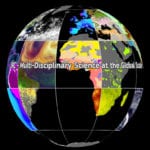Team Location: Langley Research Center, Hampton, VirginiaåÊåÊåÊåÊåÊ Authors: Michael Bender (Pennsylvania State University) Joshua Kelly (University of Rhode Island) Maureen Kelly (University of Maryland College Park) Corey Walters (Saint Louis University) Mentors/Advisers: Kenton Ross, Ph.D. (NASA, DEVELOP National Science Advisor) Beth Brumbaugh (DEVELOP Langley Center Lead) Lauren Makely (DEVELOP Langley Assistant Center Lead) Abstract: Pumice rafts are expansive masses of … Read More
Using NASA Earth Observations and a Temporal-Based Decision Model to Identify Crops
Team Location: International Research Institute for Climate and Society, Palisades, New York Authors: Sunny Ng (Columbia University) Yifang Yang (Columbia University) Mentors/Advisors: Pietro Ceccato, Ph.D. (International Research Institute for Climate and Society) Past/Other Contributors: Walter Baethgen, Ph.D. åÊ(International Research Institute for Climate and Society) Andrea Baraldi, Ph.D. (University of Maryland) Luigi Boschetti, Ph.D. åÊ(University of Idaho) Abstract: The Uruguay Ministry … Read More
Stopping the Spread of the Hemlock Woolly Adelgid
Team Location: University of Georgia, Athens, Georgia; and Marshall Space Flight Center (MSFC), Huntsville, Alabama Authors: Erica Lauren Craft (University of Alabama Huntsville) Jiaying He (University of Georgia) Xiyu Li (Clark University) Pornampai Narenpitak (University of Wisconsin-Madison) Austin Stanforth (Indiana University Indianapolis) Mentors/Advisers: Jeffrey Luvall, Ph.D. (NASA, Global Hydrology and Climate Center) Marguerite Madden, Ph.D. (University of Georgia) Steve Padgett-Vasquez … Read More
A new application to facilitate post-fire recovery and rehabilitation in Savanna ecosystems
 None of the existing information services available to the wildfire community address the specific needs of post-fire stabilization and restoration planning and monitoring vegetation recovery for semiarid lands. To assist the effort to manage savanna fires, we are developing an automated decision support system called the Rehabilitation Capability Convergence for Ecosystem Recovery (RECOVER).
None of the existing information services available to the wildfire community address the specific needs of post-fire stabilization and restoration planning and monitoring vegetation recovery for semiarid lands. To assist the effort to manage savanna fires, we are developing an automated decision support system called the Rehabilitation Capability Convergence for Ecosystem Recovery (RECOVER).
Investigating Features and Structure of Non-Convective High Wind Events
 Intense extratropical cyclones are often associated with non-convective high winds, which have devastating economic and societal impacts. This DEVELOP team will analyze the synoptic and mesoscale features of these events to investigate the presence of the sting jet and to determine whether MERRA data can adequately resolve cloud features.
Intense extratropical cyclones are often associated with non-convective high winds, which have devastating economic and societal impacts. This DEVELOP team will analyze the synoptic and mesoscale features of these events to investigate the presence of the sting jet and to determine whether MERRA data can adequately resolve cloud features.
Fostering Environmental Awareness from a Young Age: A Case Study from the IGES Art Contest
 The Institute for Global Environmental Strategies’ annual art contest serves as a prime example of integrating art and science in the classroom. Students benefit from the practice of visually sharing what they know. Instructors are able to tailor their lessons based on the artistic renderings of students.
The Institute for Global Environmental Strategies’ annual art contest serves as a prime example of integrating art and science in the classroom. Students benefit from the practice of visually sharing what they know. Instructors are able to tailor their lessons based on the artistic renderings of students.
Cloud Features and Mesoscale Structure of Non-Convective High Wind Events
 Intense extratropical cyclones are often associated with non-convective high winds, which have devastating economic and societal impacts. We will analyze the synoptic and mesoscale features of these events to investigate the presence of the sting jet and to determine whether Modern Era Retrospective-Analysis (MERRA) data can adequately resolve cloud features.
Intense extratropical cyclones are often associated with non-convective high winds, which have devastating economic and societal impacts. We will analyze the synoptic and mesoscale features of these events to investigate the presence of the sting jet and to determine whether Modern Era Retrospective-Analysis (MERRA) data can adequately resolve cloud features.
Hold the Dirt: Sedimentation and Urban Growth in an Alabama Watershed
 The reconstruction of the Highway 98 corridor through west Mobile is expected to alter the water feeding the reservoir that serves as the drinking water supply for the city. Issues include sedimentation, increased runoff from urban sources, and alteration of critical habitats. The Mobile DEVELOP team will prepare inputs for the Slope, Land Use, Exclusion, Urban Extent, Transportation, and Hillshade (SLEUTH) model. The model will be run to generate expected urban growth scenarios for the watershed.
The reconstruction of the Highway 98 corridor through west Mobile is expected to alter the water feeding the reservoir that serves as the drinking water supply for the city. Issues include sedimentation, increased runoff from urban sources, and alteration of critical habitats. The Mobile DEVELOP team will prepare inputs for the Slope, Land Use, Exclusion, Urban Extent, Transportation, and Hillshade (SLEUTH) model. The model will be run to generate expected urban growth scenarios for the watershed.
Remote Sensing of Stormwater and Wastewater Plumes in Southern California
 Stormwater runoff is a major source of marine pollution along Southern California’s coastline. Understanding the extent and location of the discharge is key to determining health risk and managing beach closures. DEVELOP’s JPL team partnered with the Southern California Coastal Water Research Project, Heal the Bay, and the Orange County Sanitation District to use NASA’s Earth observations for enhanced water quality monitoring.
Stormwater runoff is a major source of marine pollution along Southern California’s coastline. Understanding the extent and location of the discharge is key to determining health risk and managing beach closures. DEVELOP’s JPL team partnered with the Southern California Coastal Water Research Project, Heal the Bay, and the Orange County Sanitation District to use NASA’s Earth observations for enhanced water quality monitoring.











